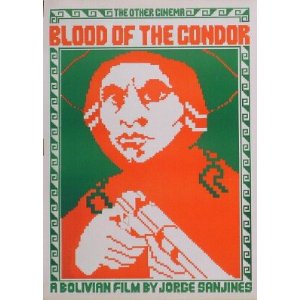Blood of the Condor
Blood of the Condor (Yawar Mallku) is a seminal Bolivian film released in 1969, directed by Jorge Sanjinés. The film is notable for its powerful portrayal of the exploitation and discrimination against the indigenous people of Bolivia. It is considered a landmark in the history of Latin American cinema, both for its artistic achievements and its political impact.
Plot[edit | edit source]
The narrative of Blood of the Condor centers around an indigenous community in the highlands of Bolivia. The story unfolds against the backdrop of the controversial operations carried out by the Peace Corps and similar organizations, which are depicted as conducting involuntary sterilization programs among the local women. This plotline is based on real accusations and events that stirred significant controversy and debate in Bolivia and beyond. The film uses this narrative to explore themes of imperialism, cultural destruction, and the struggle for sovereignty and dignity by the indigenous populations.
Production[edit | edit source]
Directed by Jorge Sanjinés, a pivotal figure in Bolivian and Latin American cinema, Blood of the Condor is distinguished by its use of non-professional actors, most of whom were indigenous people from the region where the film was shot. This choice adds a layer of authenticity and emotional depth to the portrayal of the community's experiences. Sanjinés employed a neorealistic style, emphasizing naturalistic performances and shooting on location in the rugged landscapes of Bolivia. The film's production was marked by a collaborative process between the filmmakers and the indigenous communities, which helped to inform the film's narrative and thematic focus.
Impact[edit | edit source]
Upon its release, Blood of the Condor had a profound impact both within Bolivia and internationally. It played a significant role in the expulsion of the Peace Corps from Bolivia in 1971, highlighting the power of cinema as a tool for social and political change. The film also contributed to the burgeoning of indigenous movements in Bolivia, providing a cinematic voice to the struggles and aspirations of the indigenous peoples.
The controversy and debates generated by the film underscored the complexities of international aid and the potential for neocolonial practices under the guise of assistance. Blood of the Condor remains a critical work for understanding the dynamics of power, race, and resistance in Latin America.
Legacy[edit | edit source]
Blood of the Condor is celebrated for its pioneering role in the development of a cinema that is deeply rooted in social and political realities, paving the way for future generations of filmmakers in Latin America and beyond. It is a cornerstone of the movement known as Nuevo Cine Latinoamericano (New Latin American Cinema), which sought to address the pressing issues facing the continent through a distinctly Latin American lens.
The film's aesthetic and narrative strategies have influenced a wide range of directors and scholars interested in cinema that engages with social justice themes. Its legacy is evident in the continued relevance of its themes and the ongoing struggle for indigenous rights and sovereignty in Latin America.
See Also[edit | edit source]
Search WikiMD
Ad.Tired of being Overweight? Try W8MD's physician weight loss program.
Semaglutide (Ozempic / Wegovy and Tirzepatide (Mounjaro / Zepbound) available.
Advertise on WikiMD
|
WikiMD's Wellness Encyclopedia |
| Let Food Be Thy Medicine Medicine Thy Food - Hippocrates |
Translate this page: - East Asian
中文,
日本,
한국어,
South Asian
हिन्दी,
தமிழ்,
తెలుగు,
Urdu,
ಕನ್ನಡ,
Southeast Asian
Indonesian,
Vietnamese,
Thai,
မြန်မာဘာသာ,
বাংলা
European
español,
Deutsch,
français,
Greek,
português do Brasil,
polski,
română,
русский,
Nederlands,
norsk,
svenska,
suomi,
Italian
Middle Eastern & African
عربى,
Turkish,
Persian,
Hebrew,
Afrikaans,
isiZulu,
Kiswahili,
Other
Bulgarian,
Hungarian,
Czech,
Swedish,
മലയാളം,
मराठी,
ਪੰਜਾਬੀ,
ગુજરાતી,
Portuguese,
Ukrainian
Medical Disclaimer: WikiMD is not a substitute for professional medical advice. The information on WikiMD is provided as an information resource only, may be incorrect, outdated or misleading, and is not to be used or relied on for any diagnostic or treatment purposes. Please consult your health care provider before making any healthcare decisions or for guidance about a specific medical condition. WikiMD expressly disclaims responsibility, and shall have no liability, for any damages, loss, injury, or liability whatsoever suffered as a result of your reliance on the information contained in this site. By visiting this site you agree to the foregoing terms and conditions, which may from time to time be changed or supplemented by WikiMD. If you do not agree to the foregoing terms and conditions, you should not enter or use this site. See full disclaimer.
Credits:Most images are courtesy of Wikimedia commons, and templates Wikipedia, licensed under CC BY SA or similar.
Contributors: Prab R. Tumpati, MD

